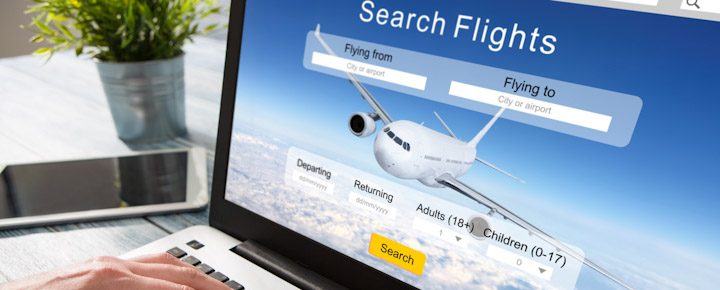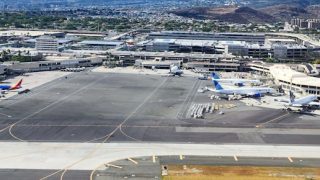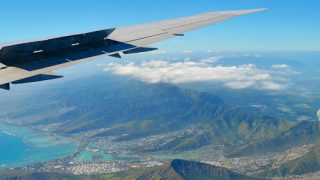A subject discussed for at least 15 or more years as folklore is the impact of web cookies on Hawaii airfares. Some have suggested that a simple trick can assure you of the lowest-priced Hawaii airline ticket. But is it true, or is it just a myth? And what has changed?
Let’s face it, the airlines and other Hawaii travel industry players know a lot about us. Too much! And they’re about to put it to great use for themselves. Think of this as similar to surge pricing when using Uber.
Debbie reminded us of this subject when she said, “We have noticed that airlines seem to know when you’re price checking. If you go back moments later on the same computer to the airline after checking around, rates seem to go up. Interesting phenomenon. So we search on one computer, then, when ready to purchase, we use another computer and usually find the original lower rate and quickly make the purchase. (I admit my hubby figured this out, not me).”
Well, not so fast, Debbie. Things are rapidly evolving, so that trick may no longer yield your expected results.
Monica added, “Variations in charges for add-ons like extra comfort are seemingly arbitrary. I changed my flight by one day, and they wanted to charge me an additional $180 when I’d already paid $170 for that one-way extra comfort seat.”
Cookies and dynamic pricing on Hawaii travel.
Cookies represent your individual data, while dynamic pricing takes it much further. Airlines know how often you and others search for the same seasons, dates, times, and routes. It doesn’t matter what device you are on or what browser you use. They use this information to moderate prices up and down throughout the day in relation to individual and group actions and demand.
So while some, like above, believe that deleting your browser cookies, whether on a phone or other device, will remove the search history and therefore restore pricing, that was the situation before dynamic pricing. As we’ve mentioned, airlines change airfares five times on most days. And those changing “dynamic” fares are based on supply and demand. Your search data and everyone else’s are combined to create a demand profile that indicates to them to increase your sought-after Hawaii airfare.
At one time, there was even a prevailing price when buying airline tickets to Hawaii. Now, however, the airlines, car rental companies, Hawaii vacation rental companies, and Hawaii hotels, too, employ sophisticated dynamic pricing of their inventory.
Enters Hawaii flight prices based on contextual signals.
Airlines don’t have a single price for a flight to Hawaii. They’ve implemented products such as Architect that help refine their “revenue management” and create pricing.
Alaska Airlines has moved to this most sophisticated dynamic pricing, in partnership with the Airline Tariff Publishing Company (ATPCO), using their “Architect” pricing tool. Airlines can spend far less time and be more effective in creating fares using Architect, which finds the highest yields using data about our shopping, among other things.
Alaska Airlines’ revenue manager Kirsten Amrine said when this was announced, “When ATPCO showed us the capabilities of Architect, we saw a clear vision that aligned with the way Alaska Airlines imagines the future of pricing management. Architect’s capabilities enable us to be even more strategic, and we are taking advantage of the efficiencies Architect offers to unlock the full revenue potential of our network and pricing strategy.”
Dynamic pricing yields higher Hawaii airfares.
There’s no doubt we can all suffer sticker shock when looking at Hawaii airfares that are climbing and setting new record levels. We know; we just paid them! That is the case in markets other than where there is still the “Southwest Effect.” Southwest remains a disruptor that helps keep Hawaii flight prices lower wherever they fly. In those markets, you’ll still find up to a 50% price reduction. Those markets are where the deals are to be found, regardless of the airline you choose or when you are traveling.
Hawaii flight costs before dynamic pricing.
Airlines previously employed what’s known as “static pricing,” wherein they created fare structures with a limited number of published prices. With static pricing, for example, airfare from LA to Honolulu remained relatively stable, at least for a certain period of time. Even with static pricing, however, variability existed for seasonality, nonstop versus with stops, days of the week, and many other factors. But you could feel reasonably confident that when you checked back, you’d probably find the same prices.
Enters Hawaii flight dynamic pricing.
With data-driven dynamic pricing tools like Architect, airlines thoroughly analyze the competitive environment and use constantly changing, actionable analytic data to create granular pricing. These tools have become essential for airlines, hotels, and vacation rentals to remain competitive and achieve maximum profitability. This is industry-wide.
Real-time pricing changes adapt to current market conditions.
With today’s dynamic pricing, the cost of your Hawaii airline ticket is constantly in flux. The airlines continually evaluate competitors’ pricing, outside events, and whatever else may cause spikes in interest, your personal searching and booking patterns, and more to determine and show you “your price.”
Ancillary charges join dynamic pricing.
The airlines reap more than $50 billion annually on extra charges like baggage, seat selection, meals, and more. These ancillary fees are ever escalating. You may recall that Jeff recently paid $142 for extra legroom on a one-way flight to Hawaii. Was that a fixed price for that seat on all flights? No, it was not. It was determined by the airline using dynamic pricing.
The dynamic pricing of ancillary fees is still new. Previously, these products were managed outside of the airfare revenue management tools. Therefore, they were generally offered static pricing without regard to factors like demand or the customer.
Remember that airlines went cashless for more reasons than you think. Your onboard purchases give them yet further insight into your behavior and preferences.
What happened to airlines having specific Hawaii airfares?
Airlines are moving to either increase the number of Hawaii airfare price points or to make them virtually unlimited. This is called Dual RDB, as proposed by ATPCO. It makes it easy for airlines to increase their options for pricing without requiring changes to fare filings, which might become automatic using this.
The ultimate weapon is continuous (total) dynamic pricing.
Continuous dynamic pricing is the end-goal method of adjusting prices in real-time based on these state-of-the-art contextual signals and artificial intelligence. IATA has named it “Dynamic Offers.” This is becoming the new standard for pricing with its holistic approach to revenue management and greatly improved demand forecasting and personalization.
Hawaii offers (packages) and what to expect.
A new product amalgamation will be arriving for Hawaii-bound visitors and elsewhere, and that’s called offer management. Think of it as the next generation of Hawaii packages, if you will, but on steroids. The idea is to present to the potential buyer the exact mix of products at the most likely price to be accepted on the spot based on that particular user. The offers may consist of both basic services and options deemed appropriate, which we can accept or reject. And guess what, based on whether we buy or don’t buy, the airlines will adjust the next set of offers accordingly.
This will increase airline purchases while, hopefully, contouring offers for what any given customer might want and either adding or eliminating options on the fly as need be. Airlines will know from your shopping experience whether, for example, you’d be open to things including a seat upgrade, a trip insurance offer, or a car rental or accommodation purchased together with your Hawaii airfare. There’s little reason to annoy the same customer with offers in which the airline knows they have repeatedly shown no interest.
What Hawaii travelers should know.
- Understand the basics of dynamic pricing and where this is headed so you don’t get caught off-guard.
- Realize that this is only going to get more sophisticated.
- For now, at least, airlines are still transitioning and working on updating old technology.
- Avoid basic economy fares if you want to have more flexibility on making changes when fares go down.
Are you ready for the next generation of travel technology? It’s here.






And, of course, last minute booking of unsold seats and rooms, but only if your significant other can stand the anxiety and possibly disappointment!
Thanks BOH guys, great piece.
I have researched this particular issue for years and I have determined a fool-proof way to get the lowest possible Hawaii airfare…. but I’m not telling anyone.
Hi Mike.
If you can outsmart the airlines in this area, our congratulations!
Aloha.
…but I will tell you.
1) Start searching for flights about 120 days before the date you want.
2) When you find a fare that you are comfortable with, buy it.
3) After that, stop checking to see if the price went down.
4) Pretend you got a great deal.
5) Enjoy your trip to Hawaii.
Hi Mike.
Thanks for sharing that plan! We like it.
Aloha.
Very interesting and detailed. Thank you for the detailed update on how things work. ~Debbie
Thank for the Great article, Folks!
Here’s a few tricks for those who are savvy (if not, ask your kids for help, LOL)
1.) Use a VPN when checking out prices and flights (prevents them from knowing your IP Address)
2,) Immediately clear the cookies on that device when done.
3.) Use DuckDuckGo Browser with the “Clear all tabs and data” (flame) feature for 1-touch erasure
4.) Don’t look at the flight you want multiple times. It increases the “Viewed Peg Count” and can cause an increase for prices on that flight, even without purchases being made.
Should be illegal. Look the next day and it jumped $250 for the same exact dates.
Also, if you’re booking 3-4 people, be sure to check the price for just 1 person and 2 people. I had to book 3 family members separately so I can get those tickets at 40k. When I punched in all 4 of us, it was 70k a person, ridiculous.
All that technology and brain power, and this is how we use it. We should be ashamed.
Why place limits on dynamic pricing? Why not include grocery stores. Can you imagine going into a store to shop, and have your food items priced dynamically while you’re shopping? You’d better check out STAT! Is it really that far fetched? How about your doctor visits and medications dynamically priced? How about gas, while you’re pumping (haven’t finished your purchase yet) you can see the price go up because there’s lots of other people pumping gas! Dynamic pricing just smacks of something, bordering on, illegal if not unethical business practice.
The supermarkets have been trying to figure out how to do dynamic pricing for years. The club cards were introduced for exactly that reason – they tried to roll out “self checkout” shopping at the same time so that your cart could display the price as you went through the store. They told customers that they wanted to offer discounts and services with those clubs – but that wasn’t the real reason. The dynamic grocery pricing hasn’t worked yet – but Amazon and others haven’t given up yet. (I spent my career in Silicon Valley doing database work. Worked with airlines and grocery stores and banks and many others.) Personally, I think we need to get government working so this can be regulated.
Yes. While I’m a capitalist at heart I see inherent dangers here, especially a type of monopoly that could force the little guy (both companies And fliers without deep pockets) out of Hawaiian air travel. This affects everyone, from tourists to Hawaiian business people and those just flying to the mainland to see family (kids at college, etc.).
It’s possibly an antitrust issue, especially if the airlines collude via a 3rd party software service.
In any case, it should remain true that booking earlier than ~6 months will tend to yield lower prices since you will be one of the first to claim empty seats and rooms.
Aloha! Very interesting article! I wonder how fare monitoring services like Google Flights and others will be affected by this. If fares change multiple times per day, or become constantly variable, will a Google Flights monitoring alert even be valid, or actually drive up a rate with everyone suddenly checking the fares after a monitoring price alert goes out? Same could be said for a Beat of Hawaii email blast about low fares. When a few hundred (or more) people suddenly check rates after a deal alert, the Architect software suddenly senses this and raises rates? Hmmm…. Mahalo for all you do BOH!
Hi Buddy.
Thanks. Good questions. This will be interesting to watch as it evolves.
Aloha.
I have seen this in action while reviewing options over time before selecting recent flights. Basically, you can not “beat” their data harvesting and end goal dynamic pricing to lock you in to what you consider to be an acceptable “highest” price you will pay. The equilizer is demand significantly going down and that is very unlikely. When AA bought US Airways a number of years back,, I noticed how AA found a way to seperate you from your money on every aspect of flying. This dynmaic pricing is just the next generation of their “revenue enhancement.” Good luck all!
I’ve tried searching incognito trying to find better prices. Lately, however, it brings up the same price. Also, don’t always search on your phone. For hotels, I’ve gotten better prices on the Marriott website via my laptop than on their app. As for premium seats prices, I check daily. Sometimes (on American) the charge will drop in half. The next day, it’s back to the higher price.
We are in the process of booking our 5th trip to the Big Island in the last 7 years, our son lives there. Thanks to you, we’ve been able to find some reasonable priced flights in the past. However, it’s been a little more challenging currently. We are flyng fron the midwest, MSP specifically, to Kona mid to the end of June. Current prices are in the $900 range, do you see them coming down in the near future? When would be the best time to buy? Thanks for all you do.
Hi Dave.
Thank you. Yes, $887 RT with the best connection on Delta. You can make it cheaper by $100 or so by flying one way on Delta and the other way on American.
It’s actually a good price for the current environment, and there’s no reason to expect it to go lower.
Aloha.
Yes, flying from anywhere else than the West Coast is expensive. East Coast and Mid West rarely get a good deal, and never on the scale of the West Coast.
If I were a skilled young program developer I would now look at the consumer side of this equation and develop the corresponding software to “counter” the sophistication of the airlines marketing. I think it would be an excellent business opportunity. I’m not sure the existing aggregators or third party broker/agents do this adequately.
Peter on Long Island
Read my post. It’s a start.